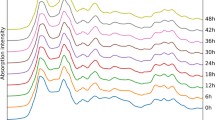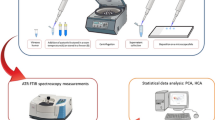Abstract
Evaluation of postmortem interval (PMI) is of paramount importance to guide criminal investigations, especially when witnesses are not found. However, accurate PMI estimation is a challenging task in the forensic community due to the limitations of existing methods. The study aims to investigate the potential of attenuated total reflectance Fourier transform infrared (ATR-FTIR) spectroscopy for predicting PMI based on vitreous humor (VH). VH samples were collected from 72 rabbits in the range of 0–48 h postmortem at a 6-h interval. Their FTIR spectra were normalized by the extended multiplicative signal correction (RMSC) and divided into calibration and validation sets. After analysis of the absorption bands, the Bayesian ridge regression (BRR), support vector regression (SVR), and artificial neural network (ANN) methods were established by the calibration set using a 10-fold cross-validation that was further used to predict the PMI in the validation set. The validity of the models was assessed by a permutation test. The current study demonstrated that multiple macromolecules in the VH samples were reflected in a FTIR spectrum, and the spectral absorption bands at 1313 and 925 cm−1 were highly correlated with PMI. The three models allowed generalization to the validation set due to similar R2 and errors between the calibration and validation tests. The highest accuracy with R2 = 0.983 and error = 2.018 h was achieved by the ANN model in the validation test. The results suggest that ATR-FTIR spectroscopy may be useful for VH analysis in order to predict PMI in the future.

ᅟ




Similar content being viewed by others
References
Mathur A, Agrawal YK. An overview of methods used for estimation of time since death. Aust J Forensic Sci. 2011;43:275–85.
Rognum TO, Hauge S, Oyasaeter S, Saugstad OD. A new biochemical method for estimation of postmortem time. Forensic Sci Int. 1991;51:139–46.
Gadzuric SB, Kuzmanovic SOP, Jokic AI, Vranes MB, Ajdukovic N, Kovacevic SZ. Chemometric estimation of post-mortem interval based on Na+ and K+ concentrations from human vitreous humour by linear least squares and artificial neural networks modelling. Aust J Forensic Sci. 2014;46:166–79.
James RA, Hoadley PA, Sampson BG. Determination of postmortem interval by sampling vitreous humour. Am J Forensic Med Pathol. 1997;18:158–62.
Rognum TO, Holmen S, Musse MA, Dahlberg PS, Stray-Pedersen A, Saugstad OD, et al. Estimation of time since death by vitreous humor hypoxanthine, potassium, and ambient temperature. Forensic Sci Int. 2016;262:160–5.
Ghanbari R, Sumner S. Using metabolomics to investigate biomarkers of drug addiction. Trends Mol Med. 2018;24:197–205.
Yang Q, Xu L, Tang LJ, Yang JT, Wu BQ, Chen N, et al. Simultaneous detection of multiple inherited metabolic diseases using GC-MS urinary metabolomics by chemometrics multi-class classification strategies. Talanta. 2018;186:489–96.
Sato T, Zaitsu K, Tsuboi K, Nomura M, Kusano M, Shima N, et al. A preliminary study on postmortem interval estimation of suffocated rats by GC-MS/MS-based plasma metabolic profiling. Anal Bioanal Chem. 2015;407:3659–65.
Kaszynski RH, Nishiumi S, Azuma T, Yoshida M, Kondo T, Takahashi M, et al. Postmortem interval estimation: a novel approach utilizing gas chromatography/mass spectrometry-based biochemical profiling. Anal Bioanal Chem. 2016;408:3103–12.
Zhang J, Niu F, Dong H, Liu L, Li J, Li S. Characterization of protein alterations in damaged axons in the brainstem following traumatic brain injury using fourier transform infrared microspectroscopy: a preliminary study. J Forensic Sci. 2015;60:759–63.
Zhang J, Liu L, Mu J, Yang T, Zheng N, Dong H. Chemical analysis in the corpus callosum following traumatic axonal injury using Fourier transform infrared microspectroscopy: a pilot study. J Forensic Sci. 2015;55:3268–75.
Pan M, Sun S, Zhou Q, Chen J. A simple and portable screening method for adulterated olive oils using the hand-held FTIR spectrometer and chemometrics tools. J Food Sci. 2018;83:1605–12.
Hutenqs C, Ludwiq B, Junq A, Eisele A, Vohland M. Comparison of portable and bench-top spectrometers for mid-infrared diffuse reflectance measurements of soils. Sensors (Basel). 2018;18. https://doi.org/10.3390/s18040993.
Mitchell AL, Cajjar KB, Theophilou G, Martin FL, Martin-Hirsch PL. Vibrational spectroscopy of biofluids for disease screening or diagnosis: translation from the laboratory to a clinical setting. J Biophotonics. 2014;7:153–65.
Mistek E, Lednev IK. Identification of species’ blood by attenuated total reflection (ATR) fouerier transform infrared (FTIR) spectroscopy. Anal Bioanal Chem. 2015;407:7435–42.
Lambert D, Muehlethaler C, Esseiva P, Massonnet G. Combining spectroscopic data in the forensic analysis of paint: application of a multiblock technique as chemometric tool. Forensic Sci Int. 2016;263:39–47.
Espinoza E, Przybyla J, Cox R. Analysis of fiber blends using horizontal attenuated total reflection Fourier transform infrared and discriminant analysis. Appl Spectrosc. 2006;60:386–91.
Manheim J, Doty KC, McLaughlin G, Lednev IK. Forensic hair differentiation using attenuated Total reflection Fourier transform infrared (ATR FT-IR) spectroscopy. Appl Spectrosc. 2016;70:1109–17.
Bueno J, Sikirzhytski V, Lednev IK. Attenuated total reflectance-FT-IR spectroscopy for gunshot residue analysis: potential for ammunition determination. Anal Chem. 2013;85:7287–94.
Owens GL, Gajjar K, Trevisan J, Fogarty SW, Taylor SE, Da Gama-Rose B, et al. Vibrational biospectroscopy coupled with multivariate analysis extracts potentially diagnostic features in blood plasma/serum of ovarian cancer patients. J Biophotonics. 2014;7:200–9.
Gajjar K, Trevisan J, Owens G, Keating PJ, Wood NJ, Stringfellow HF, et al. Fourier-transform infrared spectroscopy coupled with a classification machine for the analysis of blood plasma or serum: a novel diagnostic approach for ovarian cancer. Analyst. 2013;138:3917–26.
Paraskevaidi M, Morais CLM, Lima KMG, Snowden JS, Saxon JA, Richardson AMT, et al. Differential diagnosis of Alzheimer's disease using spectrochemical analysis of blood. Proc Natl Acad Sci U S A. 2017;114:E7929–38.
Hands JR, Dorling KM, Abel P, Ashton KM, Brodbelt A, Davis C, et al. Attenuated total reflection fourier transform infrared (ATR-FTIR) spectral discrimination of brain tumour severity from serum samples. J Biophotonics. 2014;7:189–99.
Li Q, Wang W, Ling X, Wu JG. Detection of gastric cancer with Fourier transform infrared spectroscopy and support vector machine classification. Biomed Res Int. 2013;2013:942427.
Valderrama P, Braga JW, Poppi RJ. Variable selection, outlier detection, and figures of merit estimation in a partial least-squares regression multivariate calibration model. A case study for the determination of quality parameters in the alcohol industry by near-infrared spectroscopy. J Agric Food Chem. 2007;55:8331–8.
Filgueiras PR, Alves JC, Poppi RJ. Quantification of animal fat biodiesel in soybean biodiesel and B20 diesel blends using near infrared spectroscopy and synergy interval support vector regression. Talanta. 2014;119:582–9.
Nunes KM, Andrade MV, Santos Filho AM, Lasmar MC, Sena MM. Detection and characterisation of frauds in bovine meat in natura by non-meat ingredient additions using data fusion of chemical parameters and ATR-FTIR spectroscopy. Food Chem. 2016;205:14–22.
Martin-Mata J, Lahoz-Ramos C, Bustamante MA, Marhuenda-Egea FC, Moral R, Santos A, et al. Thermal and spectroscopic analysis of organic matter degradation and humification during composting of pig slurry in different scenarios. Environ Sci Pollut Res Int. 2016;23:17357–69.
Lopes J, Correia M, Martins I, Henriques AG, Delgadillo I, da Cruz E Silva O, et al. FTIR and Raman spectroscopy applied to dementia diagnosis through analysis of biological fluids. J Alzheimers Dis. 2016;52:801–12.
Beekes M, Lasch P, Naumann D. Analytical applications of Fourier transform-infrared (FT-IR) spectroscopy in microbiology and prion research. Vet Microbiol. 2007;123:305–19.
Kretlow A, Wang Q, Kneipp J, Lasch P, Beekes M, Miller L, et al. FTIR-microspectroscopy of prion-infected nervous tissue. Biochim Biophys Acta. 2006;1758:948–59.
Chen JH, Michiue T, Inamori-Kawamoto O, Ikeda S, Ishikawa T, Maeda H. Comprehensive investigation of postmortem glucose levels in blood and body fluids with regard to the cause of death in forensic autopsy cases. Legal Med. 2015;17:475–82.
Stolyszewski I, Niemcunowicz-Janica A, Pepinski W, Spolnicka M, Zbiec R, Janica J. Vitreous humour as a potential DNA source for postmortem human identification. Folia Histochem Cytobiol. 2007;45:135–6.
Corradini B, Alù M, Radheshi E, Gabbolini V, Ferrari F, Santunione AL, et al. Estimation of the time of death through the analysis of clock miRNAs expression in blood and vitreous humor. Forensic Sci Int-Gen. 2015;5(suppl):e204–e6.
Palmiere C, Mangin P. Urea nitrogen, creatinine, and uric acid levels in postmortem serum, vitreous humor, and pericardial fluid. Int J Legal Med. 2015;129:301–5.
Osuna E, Vivero G, Conejero J, Abenza JM, Martinez P, Luna A, et al. Postmortem vitreous humor beta-hydroxybutyrate: its utility for the postmortem interpretation of diabetes mellitus. Forensic Sci Int. 2005;153:189–95.
Osuna E, Garcia-Villora A, Perez-Carceles MD, Conejero J, Abenza JM, Martinez P, et al. Vitreous humor fructosamine concentrations in the autopsy diagnosis of diabetes mellitus. Int J Legal Med. 1999;112:275–9.
Ma J, Pan H, Zeng Y, Lv Y, Zhang H, Xue A, et al. Exploration of the R code-based mathematical model for PMI estimation using profiling of RNA degradation in rat brain tissue at different temperatures. Forensic Sci Med Pat. 2015;11:530–7.
Williams T, Soni S, White J, Can G, Javan GT. Evaluation of DNA degradation using flow cytometry: promising tool for postmortem interval determination. Am J Forensic Med Pathol. 2015;36:104–10.
Madea B. Is there recent progress in the estimation of the postmortem interval by means of thanatochemistry? Forensic Sci Int. 2005;151(2–3):139–49.
Juneja A, Rana B, Agrawal RK. A novel fuzzy rough selection of non-linearly extracted features for schizophrenia diagnosis using fMRI. Comput Meth Prog Bio. 2018;155:139–52.
Alnæs D, Kaufmann T, Doan NT, Córdova-Palomera A, Wang Y, Bettella F, et al. Association of heritable cognitive ability and psychopathology with white matter properties in children and adolescents. JAMA Psychiatry. 2018;75:287–95.
Bocaz-Beneventi G, Tagliaro F, Bortolotti F, Manetto G, Havel J. Capillary zone electrophoresis and artificial neural networks for estimation of the post-mortem interval (PMI) using electrolytes measurements in human vitreous humor. Int J Legal Med. 2002;116:5–11.
Kumar S, Verma AK. Estimation of postmortem interval using the data of insulin level in the cadaver’s blood. Data Brief. 2016;7:354–6.
Zhang J, Li B, Wang Q, Li CZ, Zhang YM, Lin HC, et al. Characterization of postmortem biochemical changes in rabbit plasma using ATR-FTIR combined with chemometrics: a preliminary study. Spectrochim Acta A Mol Biomol Spectrosc. 2017;173:733–9.
Zhang J, Li B, Wang Q, Wei X, Feng W, Chen Y, et al. Application of Fourier transform infrared spectroscopy with chemometrics on postmortem interval estimation based on pericardial fluids. Sci Rep. 2017;7:18013.
Li C, Wang Q, Zhang YM, Lin HC, Zhang J, Huang P, et al. Research progress in the estimation of the postmortem interval by Chinese forensic scholars. Forensic Sci Res. 2016;1:3–13.
Author information
Authors and Affiliations
Corresponding authors
Ethics declarations
The research does not contain any experiments with human participants. All applicable international, national, and/or institutional guidelines for the care and use of animals were followed. The study has been approved by the Ethics Committee of Xi’an Jiaotong University.
Conflict of interest
The authors declare that there are no conflicts of interest.
Electronic supplementary material
ESM 1
(PDF 376 kb)
Rights and permissions
About this article
Cite this article
Zhang, J., Wei, X., Huang, J. et al. Attenuated total reflectance Fourier transform infrared (ATR-FTIR) spectral prediction of postmortem interval from vitreous humor samples. Anal Bioanal Chem 410, 7611–7620 (2018). https://doi.org/10.1007/s00216-018-1367-1
Received:
Revised:
Accepted:
Published:
Issue Date:
DOI: https://doi.org/10.1007/s00216-018-1367-1




